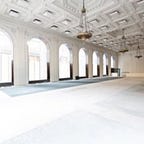How Pop-Up Shops Raise Brand Awareness
Welcome to the paradigm of the pop-up, where only the most meaningful experiences exist, and big brands can experiment in physical stores without a long-term lease. The recent rise of pop-ups reveals that the best of both worlds can come together. Utopia achieved. And the retail renaissance is just beginning.
The pop-up industry was a zero dollar industry in 2003. Today it’s valued at $50 million by research firm RetailNext. How did an industry go from zero dollars to $50 million in only fifteen years?
Enter technology and humans; as much as we love technology, we get sucked into screens and miss out on the human experience. We still truly want the experience. But we don’t want the nuisances and outdated vibe that goes along with traditional retail (we’re looking at you, pushy salespeople).
Here are three ways that pop-up shops raise brand awareness:
1. Modern customers interact with companies at multiple touch points: both digital and physical.
Successful retailers understand the importance of developing a consistent presence in both spheres, via multiple channels and offline/online strategies.
The traditional framework of retail is over, Portlandia style.
And you don’t need a hipster like Fred Armison to prove it (even though hipsters do love a good pop up). Here’s why: Let’s say that you want to sell a t-shirt. But to sell the shirt, you’ll need employees, utilities, taxes, and rent. The overhead is what makes the t-shirt expensive (not the t-shirt itself).
In an instantaneous economy, businesses seek simplicity: They need to create a product without signing up for long-term leases or promising employment. Large cities like New York and Los Angeles have expensive real estate markets. When you couple this with brands’ lack of short-term options, the conditions are ripe for the rise of the pop-up.
2. Pop-ups help the end consumer in terms of cost and time efficiencies.
The future of physical retail looks like “rogue retailing”: a model that requires more flexibility on behalf of both landlords and retailers to account for greater risk when setting up shop in the market.
Plus, did we mention the word “experience”? The pop-up shop at 718 Broadway is perfectly titled “The Velvet Underground Experience” which features photographs, portraits, films, videos, live concerts and musical workshops. The exhibitions main curator, Christian Fevret, noted in an article in the New York Times that:
“To find a place in New York for three months, where you can have 300 visitors at the same time: that’s not very easy.”
Pop-up shops are disrupting the real estate model, making it a go-to marketing strategy for retailers looking to extend the brand and introduce new products.
3. The content, commerce and food worlds are colliding — just in time for the holidays.
And media publishers, particularly in NYC’s Soho neighborhood, are taking note. According to Commercial Observer, “news organizations with food divisions have started to move from keeping its readers informed to keeping their bellies full.”
British media company Time Out Group helped kick off the trend in 2014 when it opened Time Out Market in Lisbon, Portugal.
Leading brands are reimagining the retail experience not just to drive sales, but to make otherwise boring industries fun again. Consumers look to pop-ups for specialized shopping and to cultivate a memorable experience.
Here are some key pop-ups happening now in New York City:
- New York Magazine is running a 7-week pop-up shop focused on beauty products.
- Google opened a hardware store in Soho, located at 131 Green Street (between Houston and Prince Sts)
- History, art, and a beautiful space collide at The Velvet Underground Experience (referenced earlier). I also wrote about it here.
- Daily Harvest pops up at a magical Rawspace location: 446 Broadway in Manhattan.
- During this 9-day event, customers get the Daily Harvest experience in a different way from the online version; customers can purchase items a la carte, which is not available to Daily Harvest subscription customers.
